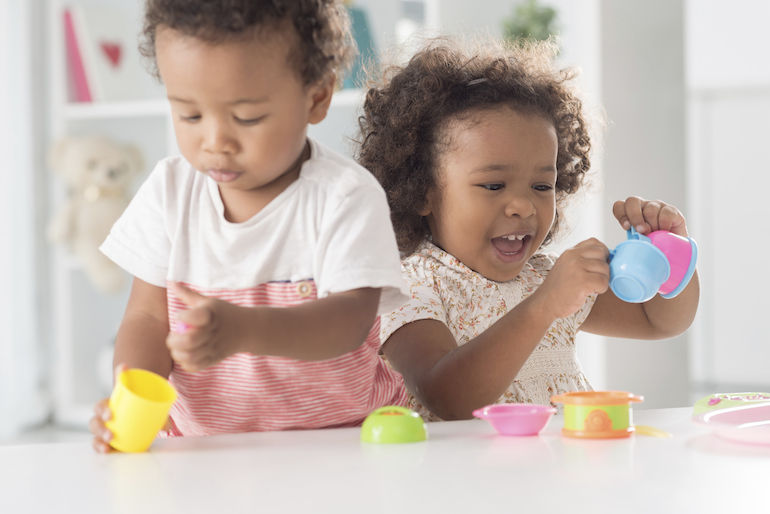The preschool years are a magical time for children. Imaginations soar because logic does not yet interfere with creativity. In other words, anything is possible. Parents can tap the imaginative capacity of children ages three to five to help them understand their adoption stories in ways they can’t yet articulate.
The Importance of Play
The most common themes of preschool play tend to be babies, birthdays, superheroes, and bad guys. Through these themes, children fulfill their need to be in control and have a sense of power; and they experiment with adult roles. Through play, children can take control of bad guys, determine outcomes of events, and even revisit their babyhoods.
When a child plays adoption games that don’t reflect the facts of his own adoption, parents may become concerned. In fact, through such games children often are merely working out feelings by rewriting the script.
Tall Tales About Life Before Adoption
Preschoolers are great tellers of tall tales — particularly when they are caught doing something wrong. They even believe their own tales. But explaining misdeeds isn’t the only use for tall tales; children tell such stories about any number of things. It’s not uncommon for children to make up stories about life before adoption with their birth parents or caretakers. In most cases, especially if your child was adopted near birth, the best approach is to nod and give an interested “Oh,” rather than debate accuracy. If the tale is about something that has recently happened, correct the child’s facts; if you are unsure of the facts, don’t worry about it.
Repeated Questions
When a three-year-old repeatedly asks the same questions about his adoption, parents sometimes worry that he is obsessed with adoption or that they, as parents, aren’t answering in a way he can understand. In fact, three-year-olds just like to ask questions over and over again, in part to see if they will get the same answer as before. But sometimes when a child repeats a question, it’s because he is thinking about the topic and wants to discuss it again, but doesn’t have the language ability to carry the conversation further. You’ll want to probe gently to find out which applies to your child.
Answers for “You’re Not My Real Mom!”
At about age four-and-a-half, temper tantrums may return, and kids’ imaginations can lead to fears of the dark, imaginary creatures, or strange noises. When children, in anger, say things like “I hate you,” “I wish you were dead,” or “You’re not my real mom or dad,” parents may overreact, interpreting such outbursts as rejection or as evidence that there is no attachment. But they are usually only expressions of frustration, not commentaries on the state of the parent/child relationship.
If you overreact to your child’s outbursts, you’ll turn them into “buttons” your child can push to coerce you into giving in to his wishes. The best approach is to deal with whatever triggered the anger. Statements such as “I know you are angry that…” recognize your child’s feelings without getting into whether the child has a “right” to feel that way.
Address “You’re not my real parent” at another time. If you feel you must to respond immediately, say something straightforward like, “You are my son. I know you are angry.” Whatever you do, don’t argue about whether or not you are the parent. By coping firmly with the issue at hand, you show that you are your child’s mother or father because you are being a parent.
Get the Story Straight Now
Three- to four-year-olds, particularly girls who know something about pregnancy, are apt to have questions about their origins, but may not always express them. Although it may seem simpler to delay adoption explanations until a later age, it is better to get the story straight now. Minimize any fears your child may have that she might have to leave you (just as she left the woman who gave birth to her) by explaining to her that adoption means she is your daughter and will live with you until she grows up. Let her know that even after she is a grownup, she will still be your daughter and you will see her often and love her as much as you do now.
Preschool girls tend to look actively for their birth mothers and are more likely than boys to approach strangers and ask, “Are you that other lady?” When this happens, parents sometimes fear that their children are seeking to replace them. In fact, what they seek is tangible evidence of the missing character in their story (the birth mother) and proof that they, too, were born, just like all the other children they know.
Talk About Your Child’s Birth
Many of us find it difficult to talk about our child’s birth. For any adoptive parent, it is far easier and more fun to talk about the child’s life since joining the family, because that is the part in which we share. Parents may need to create moments to talk with their children about their birth. Pregnancy — whether a friend’s or relative’s — provides a wonderful opportunity for opening such discussions. You’ll want to tell your child stories about her earliest life, beginning with her birth, even before she’s able to understand reproduction. Children who know nothing about the circumstances of their births may, in their concrete thinking, believe they came from an adoption agency, orphanage, or country, as opposed to having been born like all other children. You can help your child by assuring her that her birth was a miraculous and happy event.
Fears of Being Taken Away
A child may look for her birth mother and yet, at the same time, fear that her birth mother might take her away. Reinforcing through actions and words that your child belongs in your family will alleviate these fears. Showing your child photographs of the birth mother, having your child draw pictures of her, and giving the birth mother a name (using her first name if you know it, or making one up saying, “I don’t know her name, but let’s call her…”) will lessen the urge to search by offering some of the information your child is looking for.
Open Adoption: Who Are the “Real” Parents?
Even children in open adoptions may dream about a parent/child relationship with their birth parents. Adoptive parents and birth parents need to be clear in words and actions as to who are the “real” parents — the ones responsible for raising the child — and to differentiate them from the people who gave birth to, care about, and visit the child, but who are not active “parents.” Preschoolers who go on outings or day-long or overnight visits with birth parents are easily and understandably confused about the role these people play in their lives.
Is That My Birth Mother?
When preschoolers who were interracially or internationally adopted go to cultural gatherings where adults of their ethnic or racial heritage are present, they often imagine that their birth parents are there, waiting to take them back. Before the event, explain to your child that he will go with you and return home with you afterward. Tell him in advance that there will be a lot of people who look like him, but that they have families of their own and are not related to him. During the event, reassure your child by holding his hand or letting him sit on your lap. If your child asks if a certain person is his birth parent (and that person is not), say something like “No, she is (African-American, Korean, or whatever other ethnic or racial group) like you, but she isn’t related,” or “No, I think your birth mother is still in (fill in the country, city, or state), and that’s very far away.”
Growing Together
Adoption can raise many questions for parent and child alike, but most of all, it creates countless blessings for the entire family. Adoptive families flourish together, despite or perhaps because of the potential challenges. Supporting each other through periods of questioning and growth only strengthens our bonds.
This article is adapted from Real Parents, Real Children.


